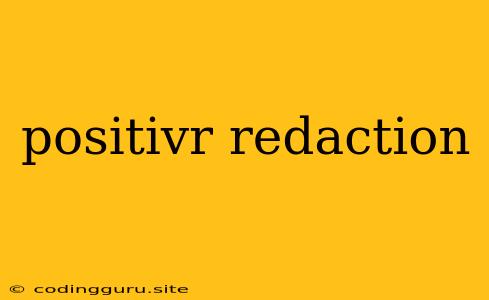What is Positive Redaction?
Positive redaction, also known as redaction by addition, is a technique used in legal and regulatory contexts to remove sensitive or confidential information from a document while still preserving its overall meaning and context. Instead of simply deleting the information, positive redaction involves replacing the removed text with a clear and concise statement that accurately reflects the nature of the redacted content.
Why is Positive Redaction Important?
- Preserves Context: Unlike traditional redaction methods that simply blank out text, positive redaction ensures that the reader can still understand the context of the document despite the removal of sensitive information.
- Enhances Transparency: By providing clear and specific explanations of the redacted content, positive redaction promotes transparency and accountability.
- Reduces Legal Risks: Using positive redaction can help minimize the risk of legal challenges or complaints related to the removal of sensitive information.
How to Use Positive Redaction Effectively
- Identify Sensitive Information: The first step is to carefully review the document and identify any information that needs to be redacted. This might include personal data, financial details, confidential business information, or any other sensitive content.
- Choose the Right Redaction Method: There are different methods of positive redaction. You can choose the method that best suits the nature of the information being redacted:
- Substitution: Replace the redacted text with a clear and concise statement that accurately reflects the nature of the removed information. For example, "[redacted: personal address]" or "[redacted: confidential financial data]".
- Summarization: Summarize the redacted content in a concise and informative manner. For example, "The [redacted: confidential contract] contains provisions related to intellectual property rights."
- Categorization: Use a generic term or category to describe the redacted content. For example, "[redacted: personal information]" or "[redacted: confidential business information]".
- Ensure Accuracy and Clarity: The replacement text should be accurate, clear, and concise. It should accurately reflect the nature of the redacted content without creating any misleading interpretations.
- Maintain Document Integrity: The redaction process should not alter the overall meaning or flow of the document. The replacement text should seamlessly integrate into the surrounding content.
- Consider Legal and Ethical Implications: Before redacting any information, consider any relevant legal or ethical requirements. Consult with legal counsel if necessary to ensure compliance with all applicable regulations.
Examples of Positive Redaction:
Original Text: "The company's annual revenue for 2023 was $100 million."
Positive Redacted Text: "The company's annual revenue for 2023 was [redacted: confidential financial data]."
Original Text: "The customer's home address is 123 Main Street, Anytown, USA."
Positive Redacted Text: "The customer's home address is [redacted: personal address]."
Benefits of Positive Redaction:
- Improved Transparency: Positive redaction allows stakeholders to understand the context of a document even with sensitive information removed.
- Enhanced Trust: By being transparent about the redaction process, organizations can build trust with stakeholders.
- Reduced Litigation Risk: Clear and concise redaction helps mitigate the risk of legal disputes related to the disclosure of sensitive information.
- Simplified Compliance: Positive redaction can simplify compliance with data privacy regulations by ensuring that sensitive information is properly redacted.
Conclusion
Positive redaction is an essential tool for protecting sensitive information while maintaining transparency and context in legal and regulatory documents. By using appropriate redaction methods and carefully considering the legal and ethical implications, organizations can effectively redact information while ensuring document integrity and stakeholder trust.
